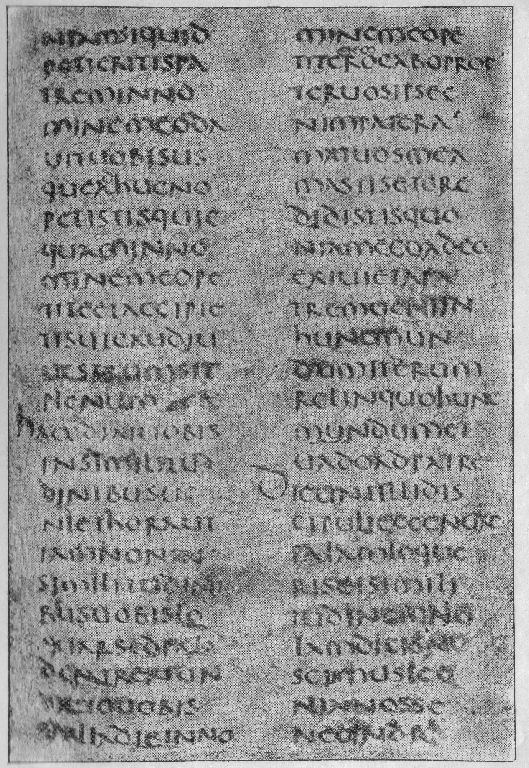 | ||
Vetus Latina ("Old Latin" in Latin), also known as Vetus Itala ("Old Italian"), Itala ("Italian") and Old Italic, is the collective name given to the biblical texts in Latin that existed before the Vulgate, the late fourth-century Latin translation of the Bible that later became the Catholic Church's standard Latin Bible. As the English translation of Vetus Latina is "Old Latin", they are also sometimes referred to as the Old Latin Bible, although they are written in the form of Latin known as Late Latin, not that known as Old Latin. The Old Latin manuscripts that are preserved today are dated from 350 to the 13th century AD.
Contents
Text
There was no single "Vetus Latina" Bible; there is, instead, a collection of biblical manuscript texts that bear witness to Latin translations of biblical passages that preceded Jerome's. After comparing readings for Luke 24:4–5 in Vetus Latina manuscripts, Bruce Metzger counted "at least 27 variant readings in the Old Latin manuscripts that have survived" for this passage alone. To these witnesses of previous translations, many scholars frequently add quotations of biblical passages that appear in the works of the Latin Fathers, some of which share readings with certain groups of manuscripts. As such, many of the Vetus Latina "versions" were generally not promulgated in their own right as translations of the Bible to be used in the whole Church; rather, many of the texts that form part of the Vetus Latina were prepared on an ad hoc basis for the local use of Christian communities, to illuminate another Christian discourse or sermon, or as the Latin half of a diglot manuscript (e.g. Codex Bezae). There are some Old Latin texts that seem to have aspired to greater stature or currency; several manuscripts of Old Latin Gospels exist, containing the four canonical Gospels; the several manuscripts that contain them differ substantially from one another. Other biblical passages, however, are extant only in excerpts or fragments.
The language of the Old Latin translations is uneven in quality, as Augustine of Hippo lamented in De Doctrina Christiana (2, 16). Grammatical solecisms abound; some reproduce literally Greek or Hebrew idioms as they appear in the Septuagint. Likewise, the various Old Latin translations reflect the various versions of the Septuagint circulating, with the African manuscripts (such as the Codex Bobiensis) preserving readings of the Western text-type, while readings in the European manuscripts are closer to the Byzantine text-type. Many grammatical idiosyncrasies come from the use of Vulgar Latin grammatical forms in the text.
Replacement
With the publication of Jerome's Vulgate, which offered a single, stylistically consistent Latin text translated from the original tongues, the Vetus Latina gradually fell out of use. Jerome, in a letter, complains that his new version was initially disliked by Christians who were familiar with the phrasing of the old translations. However, as copies of the complete Bible were infrequently found, Old Latin translations of various books of the Bible were copied into manuscripts alongside Vulgate translations, inevitably exchanging readings; Old Latin translations of single books can be found in manuscripts as late as the 13th century. However, the Vulgate generally displaced the Vetus Latina as the new Latin translation of the Bible to be used by the church after the Council of Trent.
Below are some comparisons of the Vetus Latina with text from critical editions of the Vulgate.
The following comparison is of Luke 6:1–4, taken from the Old Latin text in the Codex Bezae:
The Old Latin text survives in places in the liturgy, such as the following verse well known from Christmas carols, Luke 2:14:
The Old Latin text means, "Glory [belongs] to God among the high, and peace [belongs] to men of good will on earth". The Vulgate text means "Glory [belongs] to God among the most high and peace among men of good will on earth".
Probably the most well known difference between the Old Latin and the Vulgate is in the Pater Noster, where the phrase from the Vetus Latina, quotidianum panem, "daily bread", becomes supersubstantialem panem, "supersubstantial bread" in the Vulgate.
